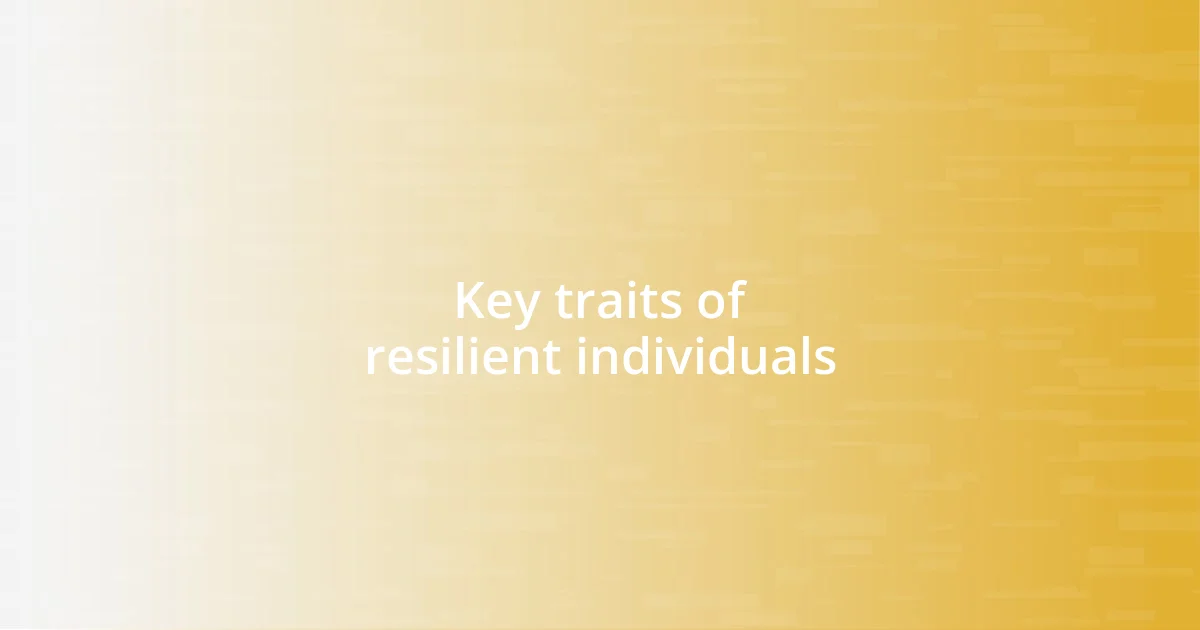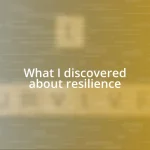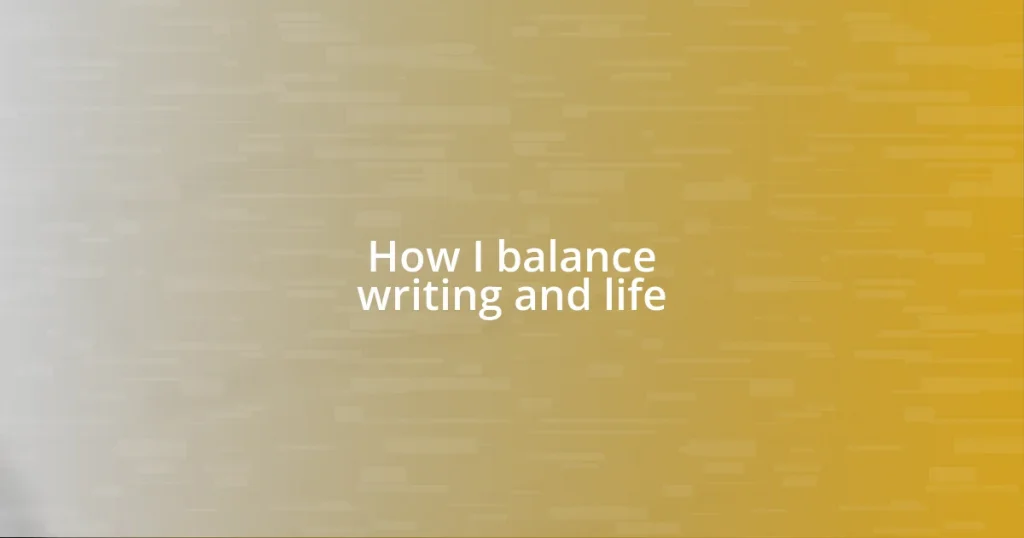Key takeaways:
- Resilience can be nurtured through emotional regulation, adaptability, and utilizing support systems during daily challenges.
- Practicing gratitude and engaging in regular physical activities are effective strategies for enhancing resilience and coping with stress.
- Overcoming setbacks involves a mindset shift, persistence, and embracing vulnerability by seeking help when needed.

Understanding resilience in daily life
Resilience is often tested in the mundane moments of daily life, not just in grand challenges. I recall a day when everything seemed to go wrong—my car wouldn’t start, I spilled coffee on my shirt, and I missed an important meeting. In that moment, rather than succumbing to frustration, I chose to laugh at the absurdity of it all. Isn’t it interesting how humor can be a powerful tool for resilience?
When faced with demands, it’s easy to feel overwhelmed. I remember juggling work deadlines while caring for a sick family member. Instead of fighting it, I embraced flexibility and asked for help. This taught me that sharing burdens doesn’t make us weak; it strengthens the fabric of our relationships and deepens our resilience. How often do we underestimate the importance of our support systems?
Understanding resilience is about recognizing our emotional responses to daily stressors. I’ve learned that moments of setback can shape our character if we allow them to. Sometimes, I ask myself, “What can I learn from this?” It’s this inquisitive mindset that empowers me to transform obstacles into opportunities for growth. In what ways have you turned your daily struggles into lessons?

The science of resilience explained
Resilience is rooted in our brain’s response to stressors; it’s a fascinating blend of biology and psychology. I’ve realized that our brain’s ability to adapt to challenges is due to its neuroplasticity—the concept that we can change our brains through experiences. For instance, during a tough period in my life, I intentionally worked on reframing negative thoughts. This mental shift didn’t just help me cope better; it profoundly altered how I perceive challenges, allowing me to face them with renewed strength.
The emotional aspects of resilience are equally crucial. Research shows that emotional regulation—our ability to manage our emotions during tough times—can significantly influence resilience. A moment that stands out for me was when a close friend faced a job loss. Instead of diving into despair, we focused on the potential opportunities ahead. Sharing those conversations not only boosted her spirits but fortified my own resilience in the process. It’s a testament to how supporting one another creates a ripple effect of strength.
Understanding the components of resilience can lead to actionable strategies in our lives. For instance, studies indicate that practicing gratitude strengthens resilience by shifting our focus from what’s lacking to what we appreciate. I started a gratitude journal, where I jot down small moments of joy, like a warm cup of coffee or a friendly conversation. This simple act has transformed my perspective, making me more adaptable in the face of adversity.
| Aspect | Details |
|---|---|
| Neuroplasticity | Our brains can adapt and change through experiences, enhancing resilience. |
| Emotional Regulation | The ability to manage our emotions significantly influences our capacity to bounce back. |
| Gratitude Practice | Focusing on gratitude can shift our perspective, strengthening resilience. |

Key traits of resilient individuals
Resilient individuals often exhibit a range of key traits that empower them to navigate life’s challenges more effectively. From my observations, adaptability stands out as a crucial quality. I once faced a significant project failure at work, and while the initial reaction was disappointment, I quickly realized that I needed to pivot and find alternative solutions. Embracing change in that moment taught me that flexibility is not just an asset but a necessity.
Key traits of resilient individuals include:
– Adaptability: The ability to adjust to new circumstances and manage unexpected changes.
– Optimism: Maintaining a hopeful attitude even during difficult times, which fuels perseverance.
– Self-efficacy: A strong belief in one’s capabilities to overcome challenges.
– Emotional Awareness: Understanding one’s feelings, which helps in managing responses to stress.
– Social Connections: Building and nurturing relationships that provide support during tough times.
Reflecting on the importance of social connections, I remember when I faced personal turmoil after a relationship ended. I leaned on my friends, and their support was invaluable. I realized that true resilience often derives from the strength we find in others, gently reminding us that we’re not alone in our struggles. This sense of community can make a significant difference in how we cope.

Practical strategies to build resilience
To build resilience, one practical strategy I’ve found incredibly effective is engaging in regular physical activity. During a particularly challenging time when I felt overwhelmed, I decided to take up running. Not only did it provide a much-needed outlet for stress, but it also gave me a sense of accomplishment with each mile I completed. Have you ever felt uplifted after a workout? That’s the power of physical activity, acting as a natural mood booster that helps fortify our emotional reserves.
Another strategy is the practice of mindfulness. I remember a time when my mind felt like it was racing in every direction, making it hard to focus. By setting aside just ten minutes a day to meditate, I learned to observe my thoughts without judgment. This small change made a big difference, allowing me to respond to stressors with a clear mind instead of reacting impulsively. How about you? Have you tried mindfulness techniques? If not, it might be worth exploring to cultivate a sense of calm amidst chaos.
Lastly, I’ve seen firsthand how setting realistic goals can enhance resilience. A few years back, I faced a daunting project at work that seemed impossible at first. Instead of feeling paralyzed, I broke it down into smaller, manageable tasks. Celebrating each completed step not only kept me motivated but also built my confidence. Isn’t it fascinating how tackling challenges piece by piece can transform our approach to larger obstacles? Embracing this method has become a cornerstone of my resilience toolkit.

Overcoming setbacks and challenges
Overcoming setbacks requires a mindset shift. I remember a time when I jarred my confidence after losing a crucial client at work. Instead of wallowing in self-pity, I chose to reassess my approach. This led me to seek constructive feedback and explore new strategies. Sometimes, our greatest growth comes from the challenges we face. How have setbacks pushed you to rethink your strategies?
When tackling challenges, I’ve found that persistence plays a significant role. There was a period when I struggled to learn a new skill that felt daunting at first. Each attempt brought its own frustrations. Yet, with each failure, I gained insight and gradually improved. It’s remarkable how persistence can turn a perceived weakness into a strength. Have you ever noticed how sticking with something, despite the odds, can lead to unexpected breakthroughs?
Lastly, embracing vulnerability can be a powerful tool in overcoming challenges. I’ve often hesitated to ask for help, thinking it might make me appear weak. Yet, I recall reaching out during a particularly tough time to discuss my struggles with someone I trusted. That conversation transformed my outlook. I realized that seeking support was not just okay but profoundly human. Isn’t it incredible how sharing our burdens can lighten the load?

Continuous growth through resilience development
Developing resilience is a continuous journey, and I’ve learned that embracing challenges often leads to unexpected growth. I once faced a situation where daily obstacles at work began to feel overwhelming. Instead of viewing them as hurdles, I chose to see them as opportunities to learn. This shift in perspective opened the door to new skills I never thought I could develop. Have you ever noticed how viewing challenges this way transforms your approach?
Another aspect of resilience development is flexibility. I remember a point when my carefully laid plans fell through, leaving me flustered. Instead of clinging to what was supposed to be, I tried to adapt to the situation. I evaluated alternatives and discovered paths I hadn’t considered before. This taught me that resilience isn’t just about persistence; it’s also about being willing to pivot. How often do you allow yourself to let go of rigidity in the face of change?
Moreover, the importance of building a supportive community cannot be understated. During a particularly difficult phase in my life, I turned to friends and colleagues for support. Their encouragement not only uplifted me but also provided different perspectives on my challenges. This collective strength fostered resilience within me, reinforcing the idea that we are stronger together. Isn’t it heartening to realize that we don’t have to face our struggles alone?













